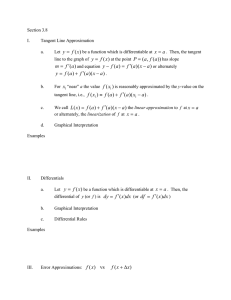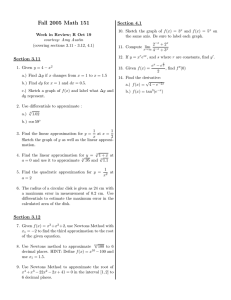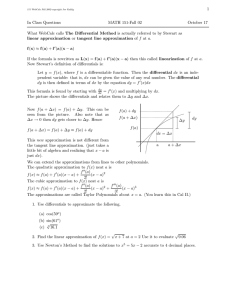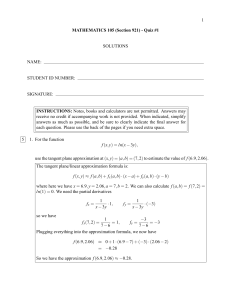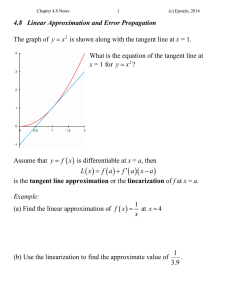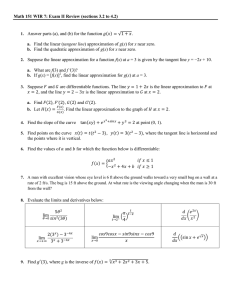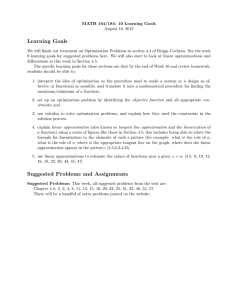146
advertisement
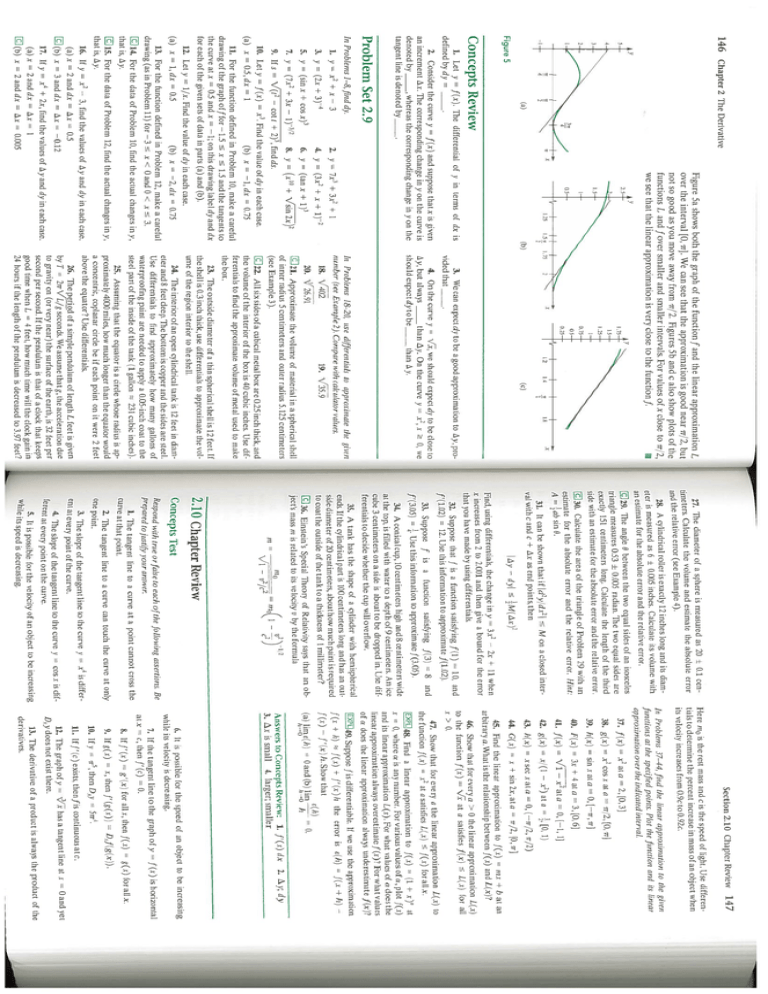
146 8. y 6. y Chapter 2 The Derivative = (tanx ± 1) i. 25. Assuming that the equator is a circle whose radius is ap proximately 4000 miles, how much longer than the equator would a concentric, coplanar circle be if each point on it were 2 feet above the equator? Use differentials. 24. The interior of an open cylindrical tank is 12 feet in diam eter and 8 feet deep. ‘The bottom is copper and the sides are steel. Use differentials to find approximately how many gallons of waterproofing paint are needed to apply a 0.05-inch coat to the steel part of the inside of the tank (1 gallon 231 cubic inches). 23. ‘The outside diameter of a thin spherical shell is 12 feet. If the shell is 0.3 inch thick, use differentials to approximate the vol ume of the region interior to the shell. 22. All six sides of a cubical metal box are 0.25 inch thick, and the volume of the interior of the box is 40 cubic inches. Use dif ferentials to find the approximate volume of metal used to make the box. 121. Approximate the volume of material in a spherical shell of inner radius 5 centimeters and outer radius 5.125 centimeters (see Example 3). 20. 18. hi Problems 18—20, use differentials to approximate the given number (see .Exanzple 2). Compare ivith calculator values. Figure 5a shows both the graph of the function f and the linear approximation L over the interval [0, ‘r]. We can see that the approximation is good near rr/2, but not so good as you move away from ir/2. Figures 5b and c also show plots of the functions L and f over = (xbo + = . Find the value of dy in each case. 3 x (b) x = —1,dx = 0.75 In Problems 1—8, find dy. 10. Let y = f(x) (a) x = 0.5,dx = 1 11. For the function defined in Problem 10, make a careful drawing of the graph off for —1.5 x 1.5 and the tangents to the curve at x = 0.5 and x = —1; on this drawing label dy and dx for each of the given sets of data in parts (a) and (b). 13. For the function defined in Problem 12, make a careful drawing (as in Problem 11) for —3 x < 0 and 0 < x 3. y, E1 14. For the data of Problem 10, find the actual changes in y, that is, iy. E1 15. For the data of Problem 12, find the actual changes in that is, y. — 16. If y = x 2 3, find the values of y and dv in each case. (a) x = 2 and dx = x = 0.5 E(b) x = 3anddx = ix = —0.12 x + 2x, find the values of y and dy in each case. 17. If y = 4 (a) x = 2 and dx = Lx = 1 26. The period of a simple pendulum of length L feet is given 2wVL7 seconds. We assume that g, the acceleration due by T to gravity on (or very near) the surface of the earth, is 32 feet per second per second. If the pendulum is that of a clock that keeps good time when L 4 feet, how much time will the clock gain in 24 hours if the length of the pendulum is decreased to 3.97 feet? cen 27. The diameter of a sphere is measured as 20 + 0.1 error timeters. Calculate the volume and estimate the absolute and the relative error (see Example 4). 28. A cylindrical roller is exactly 12 inches long and its diam volume with eter is measured as 6 + 0.005 inches. Calculate its error. an estimate for the absolute error and the relative 29. The angle 0 between the two equal sides of an isosceles triangle measures 0.53 ± 0.005 radian. The two equal sides are third exactly 151 centimeters long. Calculate the length of the relative error. side with an estimate for the absolute error and the 30. Calculate the area of the triangle of Problem 29 with an estimate for the absolute error and the relative error. Hint: A = absin0. M on a closed inter dy y/ds id I 31. It can be shown that if 2 val with c and c -I- zx as end points, then — — 2.v + 11 when 2 Find, using differentials, the change in y = 3x x increases from 2 to 2.001 and then give a bound for the error that you have made by using differentials. 32. Suppose that f is a function satisfying f(I) = 10, and f’(1.02) = 12. Use this information to approximate f(1.02). . = v’iZ /c v 2 ‘no = ino(1 — 2 2 N/ v S and 33. Suppose f is a function satisfying f(3) f’(3.05) = Use this information to approximate [(3.05). 34. A conical cup, 10 centimeters high and g centimeters wide at the top, is filled with water to a depth of 9 centimeters. An ice cube 3 centimeters on a side is about to be dropped in. Use dif ferentials to decide whether the cup will overflow. 35. A tank has the shape of a cylinder with hemispherical ends. If the cylindrical part is 100 centimeters long and has an out side diameter of 20 centimeters, about how much paint is required to coat the outside of the tank to a thickness of 1 millimeter? 36. Einstein’s Special Theory of Relativity says that an ob ject’s mass 02 is related to its velocity v by the formula 02 2.10 Chapter Review Concepts Test Respond with true or false to each of the following assertions. Be prepared to justify your answer 1. The tangent line to a curve at a point cannot cross the curve at that point. 2. The tangent line to a curve can touch the curve at only One point. y x is differ 3. The slope of the tangent line to the curve ent at every point of the curve. 4. The slope of the tangent line to the curve y = cos s is dif ferent at every point on the curve. 5. It is possible for the velocity of an object to be increasing While its speed is decreasing. Section 2.10 Chapter Review 147 Here 010 is the rest mass and c is the speed of light. Use differen tials to determine the percent increase in mass of an obj ect when its velocity increases from 0.9c to 0.92c. = 2 cos s at a x rr/2, [0. ir ata=2,(0,3] 2 x in Problems 37—44, find the linear approximation to the given functions at the specified points. Plot the function and its linear approximation over the indicated interval. 37. f(x) 38. g(x) 1 6 3x + 4ata’3,[0, 3. h(x) =sinsatao,HT,ir] = , [0. 1) 0,(—nj2,ir/2) = 0,[—1, 1] 40. F(x) = ) at a 2 x = \/Tata — xsecxata x/(l = = 41. f(x) 42. g(x) 43. h(x) , tO,wj 2 44. (3(x) = s -f sin 2x,ata = w/ 45. Find the linear approximation to f(s) = ,ns -f b at an arbitrary a. What is the relationship between f(s) and L(x)? 4.6. Show that for every a > 0 the linear approximation L(.x) L(x) for all to the function f(.t) = Vx at a satisfies f(x) 47. Show that for every a the linear approximation L(.x) to = x at a satisfies L(x) < f(s) for alix. the function f(.x) (1 -i- x) at Find a linear approximation to f(s) x = 0, whereft is anynumber. ForvariousvaluesOf,PI0t f(s) and its linear approximation L(x). For what values of a does the linear approximation always overestimate f(s)? For what values of a does the linear approximation always underestimate f(x)? — h—’O 0 and (b) lim h c(h) — = 0. 2. y; dy — 149. Suppose f is differentiable. If we use the approximation f(s) + f’(x)h the error is e(h) = f(x -I-h) f(x + h) f’(x)h.Show that f(s) (a) liine(h) Answers to Concepts Review: 1. f’(x) dx 3. ix is small 4. larger; smaller = . 4 5w = = g(x) for alix. f(s) is hori2ontal Df(g(x)). 7. If the tangent line to the graph of y x, then then D,.v = 6. It is possible for the speed of an object to be increasing while its velocity is decreasing. at x = = , 5 ir f’(g(x)) 0. c, then f’ (c) f’(x) g’(x) for alls, then f(s) 8. If 9. If g(s) 10. If y 11. If f’ (c) exists, then f is continuous ate. 0 and yet has a tangent line at s 12. The graph of y = Dy does not exist there. 13. The derivative of a product is always the product of the derivatives.
